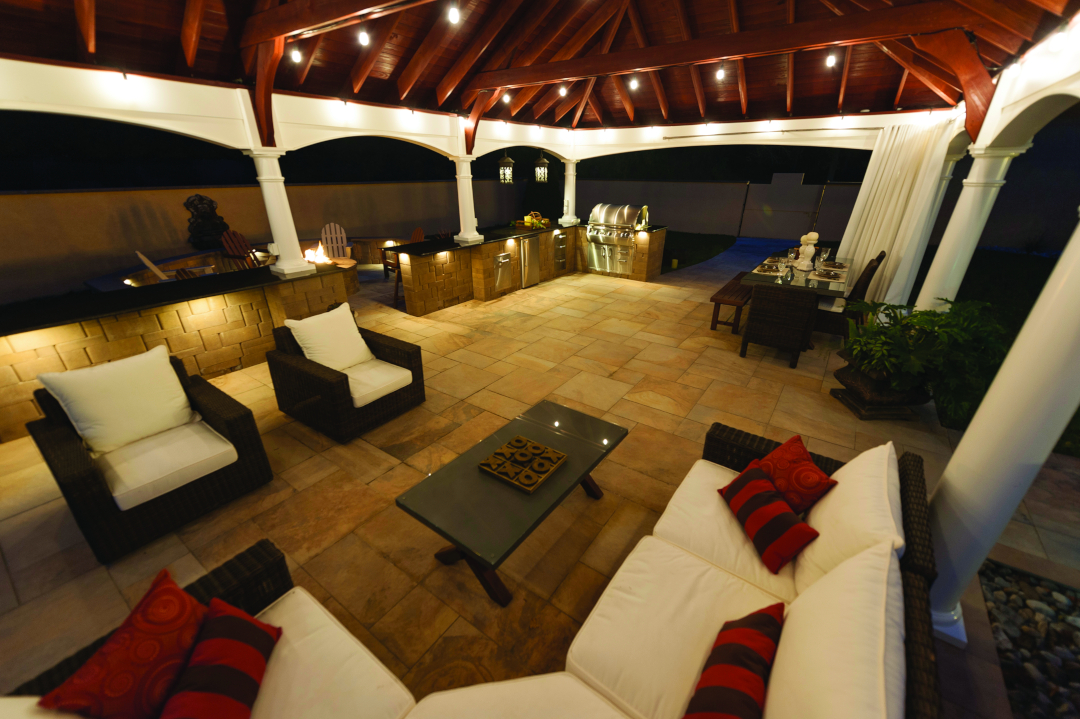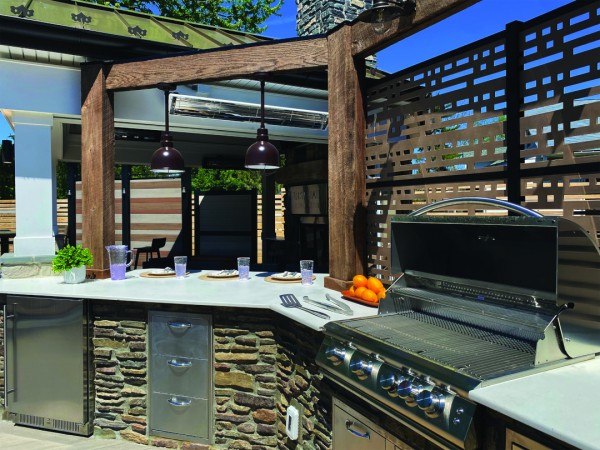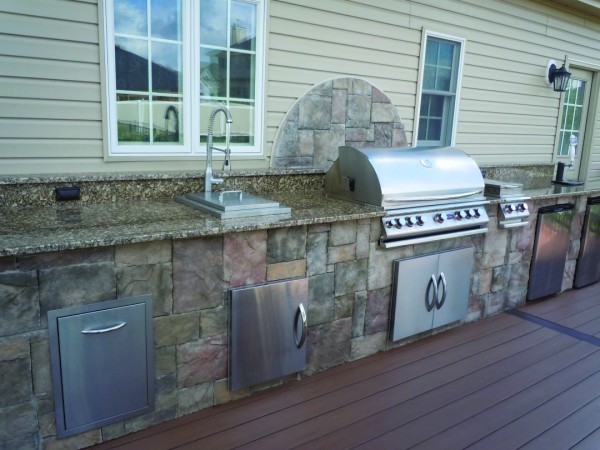Backyard Bliss

Along with family vacations, trips to the beach and baseball games, the backyard barbecue is right near the top of the list when it comes to favorite summertime activities. This longstanding tradition has only been enhanced over the past decade with the emerging popularity of outdoor kitchens, which have provided a central location for homeowners to mingle with their guests while flipping burgers and hot dogs.
 Lately, however, outdoor kitchens have included much more than just a simple grilling station and have evolved into a functional space similar to what's in the home, featuring refrigerators, sinks, prep and storage space, and trash cans. Many times they become even more elaborate and incorporate all the bells and whistles, from pizza ovens and griddles to rotisseries.
Lately, however, outdoor kitchens have included much more than just a simple grilling station and have evolved into a functional space similar to what's in the home, featuring refrigerators, sinks, prep and storage space, and trash cans. Many times they become even more elaborate and incorporate all the bells and whistles, from pizza ovens and griddles to rotisseries.
"COVID has definitely driven the demand for outdoor kitchens even further than what it was before," says Jordan Shenk of EWBN, which specializes in outdoor living projects. "People wanted outdoor kitchens prior to COVID but now it's a little bit different. They want beyond just a standard grill station in the backyard. They basically want an extension of their home, so they want their outdoor kitchens filled with many appliances to make it feel like it's a room itself."
 Not only are homeowners going bigger with their outdoor kitchens, but there's been a significant uptick in the number of projects as well. Several local experts took time out of their busy schedules to share their insight into the trends they're seeing and how a professional can help design and build an outdoor kitchen that can become a showstopper.
Not only are homeowners going bigger with their outdoor kitchens, but there's been a significant uptick in the number of projects as well. Several local experts took time out of their busy schedules to share their insight into the trends they're seeing and how a professional can help design and build an outdoor kitchen that can become a showstopper.
Imagine the possibilities
When homeowners decide to move forward with an outdoor kitchen project, the fun part is making a wish list of all the amenities they would like to include, of course with their budget in mind.
"I get excited when we start talking about outdoor kitchens because the possibilities are only as limited as your desire," says Bill Lecorchick Jr. of Legends Home Improvements. "When COVID hit, everybody started spending way more time at home and in their backyards, and now they're looking to cook all summer. It's not just burgers and dogs anymore—people want smokers and we can fit the Big Green Egg into their outdoor kitchen. We're also putting deep fryers in, pizza ovens, griddles and you can even do hibachi outside.
"Other components include the trash can, the fridge, warming drawers and cooling drawers. Anything you want to put in there, we can do it."
Joe Oakes of First State Building & Design (FSBD) begins the process by finding out as much as possible about the customer's lifestyle so he can design an outdoor kitchen that best suits their needs.
"We just ask them how they're going to use the space," he says. "What do you like to do: Do you do corn broils? Do you entertain and grill a lot? Do you need to be able to do food prep out here? We really try to understand how they're going to use the space and then direct them to the proper components. We start off by providing pricing for what it's going to cost to get water lines out there and drain lines out there. We have to make sure it's within what they want to invest in their outdoor kitchen."
Even with outdoor kitchens evolving, the grill remains the centerpiece, and Lecorchick likes to install built-in grills with 18-inch wings on either side and a natural gas line running to it, eliminating the need for a propane tank. Shenk adds that customers are seeking top-of-the-line units that are powerfully built and able to cook large meals in a short amount of time.
"We use high-end products because that's what people are looking for," she says. "They're not looking for a cookie-cutter grill from a big chain store. Those are nice but they're not going to last like these stainless steel pieces. Even if [the space is] covered, your outdoor kitchen does face the elements, the colder temperatures. So you definitely want products that are going to hold up to that."
Beyond the grills, people are adding alternative cooking methods to take their menu—and party—to the next level.
"We may only do about five or six of them per year but pizza ovens are starting to become a little more popular on the outdoor kitchens," Oakes says. "You can do a lot of things with it. A majority of the time it's used for pizza but it can be very versatile.
"It's the same thing with griddles and power burners that you can put out there: They're not just geared toward one type of food—you can do corn broils, shrimp boils. We have smokers that are going into outdoor kitchens as well with the Big Green Eggs and the Kamado grills. We're building them into the countertop or dropping them down onto their own separate platform."
While the outdoor kitchens of the past were usually linear setups, several of the professionals who spoke to House & Home say that L-shaped designs are now used a majority of the time. Incorporating a bar area near the kitchen and then a separate, outdoor "living room" with comfortable seating and a television completes the space.
"When we do a grilling area, we want to design the space so people can sit around and you can be with your guests and not off by yourself," says Bill Wilson of Amazing Decks. "We want to integrate the space. If you have people over, you're going to be grilling—that's just the way it is. But we don't want you to be separate from your guests."
"When we do outdoor kitchens, I'm always looking for an area where they can make their drinks," Lecorchick adds. "We'll do a kitchen area that is L-shaped and wrap it around and have it raised to bar height, and on that side we'll throw the refrigerator and wine cooler, along with shelves and drawers. You want to have it set up so you're not carrying everything in and out of the house."
Not just for summer
As outdoor kitchens get bigger and bigger, naturally the price tag goes up as well. So it makes sense to add some features that will allow it to be a usable space beyond just June, July and August.
"They are almost always in demand with some type of roof structure, whether that's a roof attached to the home or a custom pavilion, which is another popular choice," Shenk says. "The roof structures are great with outdoor kitchens for more reasons than one. ... It draws your eye when you have a roof structure over it and it makes it more of its own room. It also helps with those colder months and you can still use your outdoor kitchen if it's raining.
"A lot of our customers are now requesting to have fireplaces with their outdoor kitchen, and sometimes that is a gas fireplace insert but other times it is a wood-burning fireplace with hearth included and beautiful custom mason pieces that make the fireplace a showstopper in itself. Being under a structure and including some kind of warmth from a fireplace, whether it's gas or wood-burning, definitely helps extend the use of your outdoor kitchen to almost the whole year."
FSBD specializes in custom stone and masonry features like fireplaces or fire pits and encourages clients to consider the benefits.
"Having that true fire feature is something you want to think about and incorporate, whether it be a natural wood-burning fireplace or fire pit, or one that has gas lines run to it and requires less maintenance with no smoke, no wood cleanup, and you don't have to store firewood. It gives you that ambiance flame that puts out a little heat as well for when your guests come over," Oakes says. He adds that it's roughly 50-50 whether homeowners prefer a wood-burning or gas fire feature. "I would say it's a happy medium. Some people like that wood-burning smell, that atmosphere, but there are a lot of clients who like to flip a switch and have their fireplace come on."
 Lecorchick cautions that with a roof structure, it's a must to install an outdoor fan over the grill to prevent soot buildup. He is also a big proponent of adding a heating element so the outdoor kitchen can be used throughout the fall.
Lecorchick cautions that with a roof structure, it's a must to install an outdoor fan over the grill to prevent soot buildup. He is also a big proponent of adding a heating element so the outdoor kitchen can be used throughout the fall.
"Fireplaces and fire pits are great, but fireplaces do take up a lot of space," he says. "Infrared heaters are fantastic. They make it very comfortable and you won't be feeling anything out there."
Choosing the right materials
When selecting the materials for an outdoor kitchen, aesthetics and durability both must enter into the equation. Michael Chadwick of Riverside Supply Company says his team works with contractors, masons and even homeowners themselves to come up with the best materials, from stone to veneer, brick and more.
"We have a lot of people who, instead of using the paver material for the outdoor kitchens or the outdoor fireplaces, are going with either the thin veneer stone—manufactured or natural—or they're going with the thin brick if they want to add a brick motif to their outdoor area," he says. "Sometimes using the thin brick or the thin veneer stone for the outdoor kitchen, the pizza oven or the fireplace helps it stand out a little more."
Chadwick stresses that supply chain issues have hit the industry hard. Material availability has improved, but the high price to deliver materials from other parts of the country is adding significantly to the overall cost of projects.
"We try to tell people to plan ahead as much as possible, and we keep a lot of material in stock," he says. "That's one good thing—we have a pretty large area to keep a lot of stock material, especially the thin brick. The thin brick has really exploded over the last five or six years, so we stock a large amount of that."
As far as countertops for the outdoor kitchen or bar area, some of the same materials used inside are recommended, but others are not suitable for dealing with the elements.
"I like granite the best," Lecorchick says. "We've also done tops in limestone, bluestone and tile, but I like that the granite is a solid piece, it's a stone so it's porous, and it's easy to clean—you just wipe it down and away you go. With tile, we do bigger tiles and smaller grout lines so there's less of it, and that cleans up real easily too. With bluestone and limestone, if you put a wet glass on top of the stone you get a ring. It emulsifies and fades out, but it's just another thing you don't want to deal with."
"We have utilized custom flagstone for countertops and we are really getting into some cool designs using concrete countertops," Oakes adds. "You can get different colors and different edges for the concrete, from a modern finish to a rustic finish."
Standing out from the crowd
When all is said and done with the outdoor kitchen, the goal is to create a space that not only fulfills the homeowners' needs but also reflects their personalities.
"When you add in those custom requests, that's when your piece becomes super personalized, because it's one of a kind," Shenk says. "It's your project that you're creating. ... That's what we aim to do, to make that personal touch. We don't want our designs to look cookie-cutter. We want it to stand out and I think that's why our clients pick us, because they're part of the vision."
 Shenk, a history buff, notes that "summer kitchens" were used in the late 1700s and early 1800s as a separate cooking space away from the main home, so that heat from the fire didn't overpower the living area. It is interesting to see outdoor kitchens become mainstays in modern times, and she doesn't see the trend stopping anytime soon.
Shenk, a history buff, notes that "summer kitchens" were used in the late 1700s and early 1800s as a separate cooking space away from the main home, so that heat from the fire didn't overpower the living area. It is interesting to see outdoor kitchens become mainstays in modern times, and she doesn't see the trend stopping anytime soon.
"You almost see a return on investment between 100% and 200% with outdoor kitchens," she says. "They definitely increase the value of your home, and they increase the demand of people wanting it when you sell it. It's high on people's lists—not just the outdoor kitchen but the outdoor space. People want entertainment space outside."
RESOURCES
Amazing Decks
Ambler, Pa.
Flemington, N.J.
(215) 654-1886
AnotherAmazingDeck.com
EWBN
New Holland, Pa.
(717) 355-0741
EWBN.net
First State Building & Design
Chadds Ford, Pa.
(484) 303-4384
FSBD.co
Legends Home Improvements
East Brunswick, N.J.
(732) 955-6321
LegendsBuilt.com
Riverside Supply Company
Sayreville, N.J.
(732) 257-3434
RSC-NJ.com
Published (and copyrighted) in House & Home, Volume 22, Issue 9 (June 2022).
For more info on House & Home magazine, click here.
To subscribe to House & Home magazine, click here.
To advertise in House & Home magazine, call 610-272-3120.
